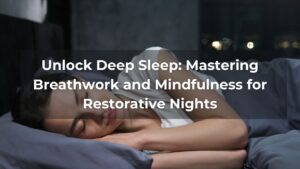“Have you ever spent a night tossing and turning, your mind racing with worries and to-do lists? Many of us battle insomnia and wake up feeling more exhausted than when we went to bed. Our sleep becomes fragmented, and even when we manage to fall asleep, we rarely feel truly rested. However, through consistent practice of mindfulness and breathwork, we can transform our sleep. We can fall asleep easily, enjoy deeper, more restorative rest, and wake up feeling refreshed and ready to take on the day. This isn’t just anecdotal; science backs it up.”
Why is Sleep So Elusive?
In our modern world, we’re constantly bombarded with stimuli – blue light from screens, the pressure of work and daily life, and a general sense of always being “on.” This constant stimulation keeps our nervous systems in a state of high alert, making it difficult to switch off and relax into sleep.


The Power of Breath: Your Nervous System’s Reset Button
Your breath is the most direct link to your nervous system. When you breathe rapidly and shallowly, your body perceives it as a sign of stress. Conversely, slow, controlled breathing activates the parasympathetic nervous system – your “rest and digest” mode – signaling to your body that it’s safe to relax and sleep. This is a core principle of the Oxygen Advantage method, which emphasises optimising breathing for better health and performance.
Mastering Breathwork for Sleep:
Here are some powerful breathwork techniques, incorporating Oxygen Advantage principles, that you can use to improve your sleep:
- Light, Slow, and Deep Nasal Breathing (LSD): This foundational practice focuses on breathing less air, which might seem counterintuitive. However, it increases carbon dioxide (CO2) levels in the blood, which has a calming effect on the nervous system and promotes relaxation. Before bed, lie down comfortably. Gently close your mouth and breathe lightly through your nose. Focus on the sensation of the breath entering and leaving your nostrils. Your abdomen should rise and fall only slightly. The goal is to breathe so lightly that you barely feel the air moving. Practice this for 5-10 minutes.
- Breath Holds for Deeper Relaxation: This technique builds on LSD breathing and further enhances CO2 tolerance. After a light nasal inhale and exhale, gently pinch your nose and hold your breath for 3-5 seconds. Don’t force it – the hold should feel comfortable. Release your nose and resume light, relaxed nasal breathing for a few breaths. Repeat this cycle 4-5 times. This practice helps to calm the nervous system and prepare the body for deep sleep. Caution: Breath holds may not be suitable for everyone. Consult with your doctor if you have any underlying health conditions.
- Extended Exhales for Sleep Induction: This technique focuses on lengthening the exhale to activate the vagus nerve, which further shifts the body into parasympathetic mode. Inhale lightly through your nose for a count of 4. Exhale slowly and completely through your nose for a count of 6-8. Pause briefly before inhaling again. Repeat this for 5-10 minutes before bed.
- The 4-7-8 Breathing Method: This popular technique combines breath holding with a specific rhythm to calm the mind and body. Inhale deeply through your nose for a count of 4. Hold your breath gently for a count of 7. Exhale slowly and completely through your mouth for a count of 8, making a gentle whooshing sound. Repeat this cycle 4-6 times.
Mindfulness Practices for a Tranquil Night:
Mindfulness, the practice of present moment awareness, complements breathwork beautifully. Here are a few practices to incorporate into your bedtime routine:
- Body Scan Meditation: Lie on your back and close your eyes. Bring your attention to your toes, noticing any sensations without judgment. Gradually move your awareness up your body, scanning each part – your feet, calves, knees, thighs, and so on – all the way to the top of your head. If you notice any tension, gently breathe into that area and imagine it softening and tell your body to let go with each exhale.
- Gratitude Reflection: Instead of dwelling on worries before sleep, shift your focus to gratitude. Reflect on three things you’re grateful for from your day. This simple practice helps to cultivate positive emotions and promotes a sense of peace.
- Progressive Muscle Relaxation: This technique involves tensing and releasing different muscle groups in your body to release physical tension. Start with your toes and work your way up, tensing each muscle group for a few seconds and then releasing. This can be particularly helpful for releasing tension you might not even realise you’re holding.
Essential Sleep Hygiene Tips:
- Digital Detox: Avoid screens at least an hour before bed. The blue light emitted from devices interferes with melatonin production, a hormone that regulates sleep.
- Create a Relaxing Bedtime Routine: Establish a consistent routine to signal to your body that it’s time to sleep. This could include a warm bath, reading a book, or listening to calming music.
- Optimise Your Sleep Environment: Make sure your bedroom is dark, quiet, and cool. A comfortable mattress and pillows are also essential.
- Avoid Late Meals and Stimulants: Avoid eating heavy meals close to bedtime, and limit caffeine and alcohol intake, especially in the evening.
Your Path to Restorative Sleep Starts Now:
Ready to experience the transformative power of breathwork and mindfulness? Tonight, commit to trying the Light, Slow, and Deep Nasal Breathing (LSD) technique for just 5 minutes before bed. Focus on the gentle rhythm of your breath and the feeling of relaxation spreading through your body. Notice how you feel as you drift off to sleep. Over the next week, incorporate one additional technique from this article each night. Track your sleep quality in a journal. You’ll be amazed at the difference consistent practice can make. Sweet dreams await!




